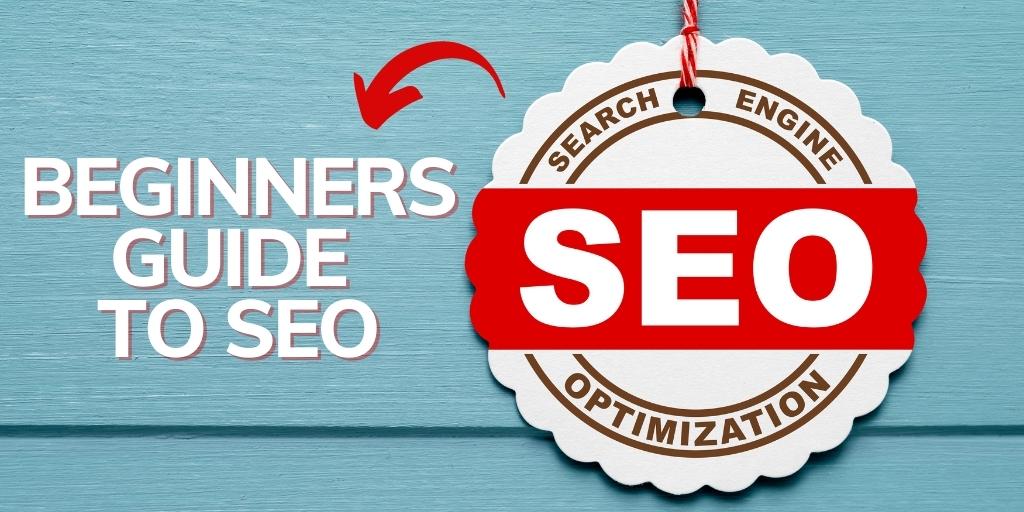
Welcome to our official beginner’s guide to SEO where you will learn all the basics and advanced knowledge about search engine optimization. Search engine optimization (SEO) is the process of improving the ranking of a website on search engines like Google. When a website ranks higher in search results, it is more likely to receive organic traffic, which can lead to increased brand awareness and higher sales and revenue. SEO is a crucial component of digital marketing, as it helps businesses to reach their target audience through search engines.
For beginners, SEO can seem like a daunting task. There are many factors to consider, and the algorithms used by search engines are constantly changing. However, with a little bit of knowledge and some guidance, you can begin to optimize your website for search engines and improve your chances of ranking higher.
Keywords
One of the first steps in SEO is to choose the right keywords. Keywords are words or phrases that describe the content on your website and that people use to search for information online. When choosing keywords, it’s important to consider the relevance of the keyword to your business, as well as the competitiveness of the keyword.
There are a few different tools you can use to help you choose the right keywords for your website. Google’s Keyword Planner is a free tool that allows you to enter a keyword or phrase and see how many people are searching for it each month, as well as how much competition there is for that keyword.
Incorporate Keywords Into Content
Once you have chosen your keywords, the next step is to incorporate them into your website’s content. This can be done in a number of ways, such as by including the keywords in the title and headings of your pages, using them in the body of your content, and including them in the alt text of images. It’s important to use keywords naturally and not stuff them into your content, as this can make your content difficult to read and may even result in a penalty from search engines.
On-Page SEO Techniques
In addition to including keywords in your content, there are a few other on-page SEO techniques you should be aware of. These include:
Using descriptive and relevant title tags and meta descriptions: Title tags and meta descriptions are pieces of HTML code that appear in the search results and give users a brief overview of what your page is about. They should be concise and contain your primary keyword.
Having a clean and easy-to-navigate website: A well-organized website with a clear hierarchy and easy-to-use navigation will help search engines understand the structure of your site and make it easier for users to find what they are looking for.
Using header tags appropriately: Header tags (H1, H2, etc.) help to break up your content into sections and signal to search engines the hierarchy of your content. It’s important to use header tags appropriately and not overuse them.
Off-Page SEO Techniques
In addition to on-page SEO, it’s also important to consider off-page SEO factors. Off-page SEO refers to factors that occur outside of your website that can impact your ranking on search engines. Some of the most important off-page SEO factors include:
Backlinks: Backlinks are links from other websites to your website. They are considered a vote of confidence in the quality of your content and can help to improve your ranking on search engines. However, it’s important to note that not all backlinks are created equal. It’s better to have a few high-quality backlinks from reputable websites than a large number of low-quality backlinks.
Social media: Social media can play a role in SEO, as search engines may consider the number of shares and likes a page receives when determining its ranking.
Other Factors Responsible for Improving SEO
There are many other factors that can impact your website’s ranking on search engines, and it can be overwhelming for beginners to try to keep up with all of them. However, there are a few more key concepts that are important to understand.
Technical SEO
One important aspect of SEO is technical SEO. Technical SEO refers to the underlying technical aspects of your website that can impact its ranking on search engines. Some of the key technical SEO factors to consider include:
Page speed: Page speed is the amount of time it takes for a page to load. Search engines consider page speed when ranking websites, as faster loading times tend to lead to a better user experience. There are a number of tools you can use to test your page speed, such as Google’s PageSpeed Insights, and there are a number of steps you can take to improve it, such as optimizing images and minifying CSS and JavaScript.
Mobile-friendliness: With the increasing use of mobile devices to access the internet, it’s important to ensure that your website is mobile-friendly. This means that it should be easy to read and navigate on a smartphone or tablet. Google has a mobile-friendly test tool that allows you to check if your website is mobile-friendly.
XML sitemaps: An XML sitemap is a file that lists all of the pages on your website, along with other important information about each page, such as when it was last updated. XML sitemaps help search engines to crawl and index your website more efficiently.
Local SEO
Another important aspect of SEO is local SEO. Local SEO refers to the process of optimizing your website for local search results. This is especially important for businesses that serve a specific geographical area, such as a restaurant or retail store.
There are a few key factors to consider when optimizing for local search:
Google My Business: Google My Business is a free tool that allows you to manage how your business appears on Google. This includes your business name, address, phone number, and business hours, as well as photos and reviews. It’s important to ensure that your Google My Business listing is accurate and up-to-date.
Local citations: Local citations are mentions of your business on other websites, such as directories and review sites. It’s important to ensure that your business is listed consistently on these sites, with the same name, address, and phone number.
Customer reviews: Customer reviews can have a big impact on your local SEO. Encourage your customers to leave reviews on your Google My Business listing, as well as other review sites like Yelp and TripAdvisor.
Best Practices To Improve SEO
In addition to the factors mentioned above, there are a few other best practices to keep in mind when it comes to SEO. These include:
Creating high-quality, unique content: Search engines value websites that provide useful and informative content. It’s important to create original, well-written content that is relevant to your target audience.
Using internal linking: Internal linking refers to the practice of linking to other pages on your own website. This helps search engines to understand the structure of your website and can also help to improve the user experience.
Being patient: SEO is a long-term strategy and it can take time to see results. It’s important to be patient and consistently work on improving your website’s ranking over time.
Some Advanced Concepts To Help You Understand SEO Better
Here are a few advanced SEO concepts that you may want to consider as you continue to optimize your website:
Latent Semantic Indexing (LSI) keywords: LSI keywords are related terms that search engines use to understand the context of a webpage. Using LSI keywords in your content can help to improve the relevance of your page to a particular keyword and increase its chances of ranking higher.
User experience (UX) signals: UX signals refer to factors that impact the user’s experience when visiting a website. These can include the overall design and layout of the website, the ease of navigation, and the quality of the content. UX signals can have an indirect impact on SEO, as a positive user experience can lead to increased engagement and more backlinks.
Structured data: Structured data is a standardized format for providing information about a webpage to search engines. By using structured data, you can help search engines to understand the content of your page and display it more prominently in search results.
Schema.org: Schema.org is a collaborative, community-driven project that provides a standardized set of definitions for structured data. By using schema markup, you can provide search engines with additional context about your content and improve its visibility in search results.
Disavow tool: The disavow tool is a tool provided by Google that allows you to tell the search engine to ignore certain backlinks to your website. This can be useful if you have a large number of low-quality or spammy backlinks that you want to exclude from your link profile.
Robots.txt file: The robots.txt file is a file that you can create and place on your website to tell search engines which pages or files they should not crawl. This can be useful if you have pages on your website that you don’t want to be indexed, or if you have technical issues that you need to resolve before search engines can access your site.
Canonical tags: A canonical tag is an HTML tag that tells search engines which version of a webpage is the original and should be indexed. This can be useful if you have duplicate content on your website, or if you have different versions of a webpage (such as a desktop version and a mobile version). Using canonical tags can help to prevent search engines from penalizing your website for duplicate content.
Redirects: A redirect is a way to send users and search engines to a different URL than the one they originally requested. There are a few different types of redirects, including 301 redirects (permanent) and 302 redirects (temporary). Redirects can be useful if you have changed the URL of a page on your website, or if you have consolidated multiple pages into a single page.
Link building: Link building is the process of acquiring backlinks from other websites. As mentioned earlier, backlinks are considered a vote of confidence in the quality of your content and can help to improve your ranking on search engines. There are a number of different strategies for building backlinks, including guest blogging, broken link building, and creating infographics.
Content marketing: Content marketing is the practice of creating and distributing valuable, relevant, and consistent content to attract and retain a clearly defined audience. In the context of SEO, content marketing can be an effective way to attract backlinks and improve your ranking on search engines.
Influencer outreach: Influencer outreach is the practice of building relationships with influential people in your industry in order to promote your content and improve your visibility online. By partnering with influencers, you can access their audience and increase the reach of your content.
PPC advertising: PPC (pay-per-click) advertising is a form of online advertising in which you pay each time someone clicks on one of your ads. PPC can be an effective way to drive targeted traffic to your website and can be a useful complement to your SEO efforts.
A/B testing: A/B testing (also known as split testing) is the process of comparing two versions of a webpage to see which one performs better. This can be a useful way to optimize your website for search engines, as it allows you to see which changes have the biggest impact on your ranking.
Conversion rate optimization (CRO): Conversion rate optimization is the process of improving the percentage of visitors to your website who take a desired action, such as filling out a form or making a purchase. By improving your conversion rate, you can increase the overall effectiveness of your website and improve your return on investment.
Custom 404 pages: A 404 page is a webpage that is displayed when a user tries to access a page that doesn’t exist. Custom 404 pages can be a useful way to handle errors on your website and improve the user experience. By creating a custom 404 page that provides helpful information and links, you can help users to find what they are looking for and reduce the likelihood that they will leave your website.
Structured data markup: Structured data markup is a way to annotate your website’s HTML with additional information that search engines can use to understand the content of your page. By using structured data markup, you can improve the way your website appears in search results and make it more attractive to users.
Accelerated Mobile Pages (AMP): AMP is an open-source project that aims to improve the performance of webpages on mobile devices. By using AMP, you can create pages that load faster on mobile devices, which can improve the user experience and potentially improve your ranking on search engines.
Multilingual SEO: If you have a website that serves multiple countries or languages, it’s important to consider the unique SEO needs of each language or country. This can include using hreflang tags to indicate the language and country of a webpage, as well as creating separate country-specific versions of your website.
International SEO: International SEO refers to the process of optimizing your website for search engines in multiple countries. This can include using country code top-level domains (ccTLDs), creating country-specific versions of your website, and using hreflang tags.
Keyword research in multiple languages: If you are targeting multiple languages, it’s important to do keyword research in each language to understand what users are searching for.
Server location: The location of your server can impact your ranking on search engines, as search engines may favor websites that are hosted closer to the user. If you are targeting a specific country or region, it can be beneficial to host your website on a server located in that country or region.
Image optimization: Optimizing images for search engines can help to improve the loading speed of your website and make it more attractive to users. This can include using descriptive, keyword-rich file names, as well as compressing images to reduce their file size.
Voice search optimization: With the increasing popularity of voice assistants like Siri and Alexa, it’s important to consider the impact of voice search on SEO. Voice search queries tend to be longer and more conversational than text-based queries, so it’s important to optimize your website for long-tail keywords and natural language.
Video SEO: Video can be an effective way to engage users and improve your ranking on search engines. To optimize your videos for search engines, it’s important to use descriptive and keyword-rich titles and descriptions, as well as to include closed captions and transcripts.
Rich snippets: Rich snippets are additional pieces of information that can be displayed in search results, such as ratings and reviews. By using structured data markup, you can improve the way your website appears in search results and make it more attractive to users.
Google Search Console: Google Search Console is a free tool provided by Google that allows you to monitor and maintain your website’s presence in Google search results. It can be a useful resource for identifying and fixing technical issues, as well as for tracking your website’s performance.
Google Analytics: Google Analytics is a free tool that allows you to track the traffic and behavior of visitors to your website. It can be a useful resource for understanding the effectiveness of your SEO efforts and identifying areas for improvement.
Log file analysis: A log file is a record of all the visits to your website. By analyzing log files, you can gain a deeper understanding of how search engines are crawling and indexing your website, as well as identify any technical issues.
Server logs: Server logs are records of all the activity on a server. By analyzing server logs, you can gain a better understanding of how your website is being accessed and identify any technical issues.
HTTP header analysis: The HTTP header is a piece of information that is sent between a client (such as a web browser) and a server. By analyzing HTTP headers, you can gain a better understanding of how your website is being accessed and identify any technical issues.
On-page content analysis: On-page content analysis involves analyzing the content of your website to identify areas for improvement. This can include analyzing the length and structure of your content, as well as the use of keywords and headings.
Off-page content analysis: Off-page content analysis involves analyzing the content of other websites that link to your website. This can be a useful way to identify opportunities for building backlinks and improving your ranking on search engines.
I hope this SEO Guide for Beginners has been helpful! SEO is a complex and constantly evolving field, and it can be difficult for beginners to keep up with all of the latest trends and best practices. However, by learning and adapting, you can improve your website’s ranking on search engines and reach your target audience.



